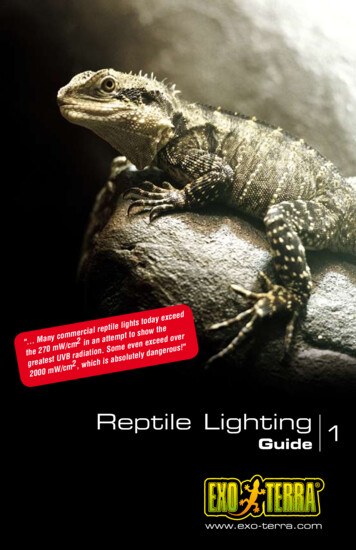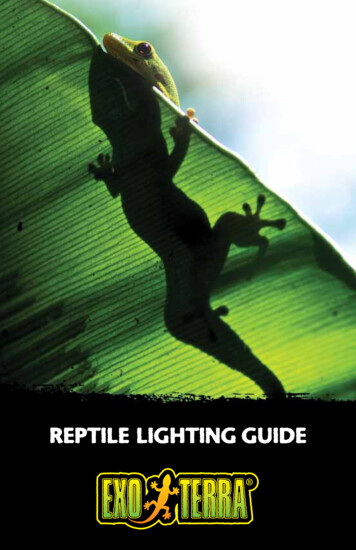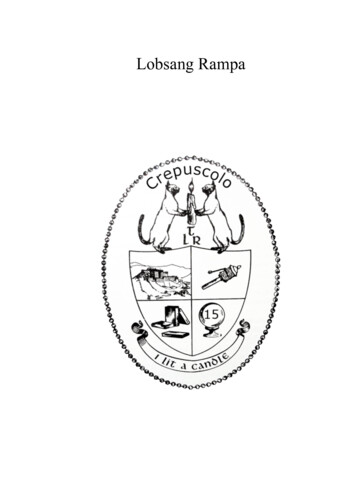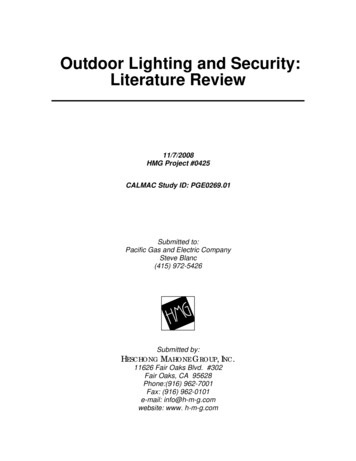
Transcription
dy exceehts todagliletierepshow thmercialny com 2 an attempt tod overeecx". Maven e/cm inee"Wmmo0gerous!tion. Sthe 27tely danB radialuVoUsbtsagreate2 which isW/cm ,2000 mReptile LightingGuide1
“The sun, with all those planets revolvingaround it and dependent on it, can stillripen a bunch of grapes as if it hadnothing else in the universe to do.”Galileo Galilei (1564)Measuring UVB intensity near Lokobe Forest, Madagascar.". Many commercial reptile lights today exceed this 270 mW/cm2 in an attemptto show the greatest UVB radiation. Some even exceed over 2000 mW/cm2, whichis absolutely dangerous! Especially if you know that the 270 value of the sun isonly measured at high noon on a clear day while most light bulbs are on between10 and 12 hours with constant values. Reptiles accumulate these UVB rays duringthe day (10 to 12 hours), so there is absolutely no need to even emit 270 mW/cm2continuously."We know, we have been there.Each year Exo Terra organizes at least one expedition to one of the world's reptilehotspots. In these reptile biodiversity concentrations we collect ecological,geographical and climatological data; including UVB levels. This is the only wayto get a better insight into the needs of reptiles and amphibians. This collecteddata is incorporated into our product development process in order to ensureoptimal results.Cover photo: Physsignathus lesueurii, Australia
IntroductionMore is not always better!The Exo Terra Reptile Lighting Guide provides information on the various types of reptilelighting available, complete with an in-depth explanation about light and the crucial part it plays insuccessful reptile keeping.What is the role of lighting in reptile keeping?More is not always better!5Incandescent Light Bulbs17What is light?8Fluorescent Bulbs20Visible Light8Compact Fluorescent20Ultraviolet Light9Linear Fluorescent23Infrared Light11Fixtures25The Intensity11Terrarium Canopies26Lighting14Fluorescent Light Controllers30Self-Ballasted Mercury Vapour 15Screw-based Fixtures32HalogenApplications3416Light has several functions:Indicating night/day cycleProviding light to see properlyEnvironment perception (visual & UV)Agonistic and signaling communication (visual & UV)Physiological well-being (UVA)Photosynthesis of pre-vitamin D3 (UVB)Coloration is light intensity dependentThermo-regulation (infrared)Is the importance of light often underestimated?Yes, absolutely. Especially when it comes to intensity of both UV and visual light. Often though,the importance of high levels of UVB light is overestimated; "More is not always better". In lightingthere are many aspects and it is important to offer a balanced lighting system. It has to cover thesimple aspects from indicating day and night cycle to more complex issues like photosynthesis.Unfortunately consumers often only use incandescent lights, which in most cases are totallyinadequate.What is the relationship between reptiles and the sun?The sun’s energy ultimately drives all life processes on earth and reptiles are no exception. If wefail to provide the important life sustaining aspects of this energy in captive conditions we will failto maintain thriving terrarium populations, not to mention reproduction.Which artificial light source is capable of providing visual light, UV lightand infrared light (or heat)?The only light source today that is capable of providing the three important aspects of light (UV,visual and infrared light) in a somewhat balanced way is a mercury vapor bulb. Unfortunately thesebulbs are not suitable for the smaller terrariums because of their high wattage.If heat is infrared light, how do I create heat gradients?In heat you have conduction, convection and radiation. Heat gradients are automatically createdwhen a light source is used as a heat source on top of the terrarium. The first energy to strike theambient air and the objects therein is the radiation. The heated air will then result in convectionwhereas the heated objects will provide conduction of the heat. The nature of different matters (air,wood, glass, plants, sand, etc.) will result automatically in heat gradients. A well-decorated terrarium increases these heat gradients by preventing the radiation to reach the substrate or underlyingdimensions.Reptile Lighting4Introduction
It is said that nocturnal and carnivorous reptiles do not need Ultravioletlight, in which case is an incandescent light bulb sufficient?Not necessarily. Incandescent bulbs are suitable light sources for nocturnal reptiles in some cases.However, we have to take into account that many nocturnal reptiles are exposed to direct or scattered sun light during the day. Some reptiles rest/sleep on tree trunks or outcrops during the day,some deliberately bask during daytime hours while feeding at night, and others start their activitybefore sunset. This means that some form of photosynthesis takes place with these species.Also many carnivorous reptiles still need UV light for photosynthesis purposes, correct environment, food and signaling perception. Not all carnivorous prey is capable of supplying the necessary vitamin D3 levels. If the prey’s liver is not consumed, vitamin D3 intake is inadequate.We can thus state that many nocturnal and carnivorous still require balanced lighting systems andthat several more factors, other than just day and night cycle or infrared exposure have to be takeninto account.What are the pros and cons of fluorescent lights?Fluorescents are the most economical light source, both in energy consumption and price. Theyare capable of emitting high levels of UV combined with acceptable levels of visual light. Thehigher the amount of visual light the lower the UV emission and vice versa. A combination of twofluorescents (visual UV) and a basking light (incandescent) is recommended since fluorescentlights fail to produce sufficient heat.Compact fluorescents have the same spectrum characteristics and emission as linear fluorescents.Due to their compact size, and because they are self ballasted, they are often easier to install thanlinear bulbs that still require a ballast.What are the pros and cons of Mercury vapor lights?These bulbs have it all: UV, high visual light output and sufficient infrared radiation. However,the disadvantage is that they consume a lot of energy (100 watt and plus) in order to operateproperly. The lower the wattage, the less stable the bulb is. They are thus only suitable for verybig terrariums.What are the pros and cons of Incandescent lights?Incandescents are inexpensive but are not very energy efficient when it comes to visual light. Theyare excellent as an infrared source to increase the ambient air temperature or as basking light. Thistype of light source also fails to produce any UVB radiation.What are the pros and cons of Metal halide?Metal halides are one of the best possible light sources around, the drawback is that they are veryexpensive. They have a very high light output, are capable of producing sufficient UV levels, andhave a high infrared radiation. The installation is very expensive since a ballast is needed plus aspecial fixture.The new HCI (Osram) or CDM (Philips) fits any HQI (Metal halide) fixture but has a greater visuallight production with the same energy consumption. The advantages are the same then as thoseof metal halide.Reptile Lighting6More is not always better!What are the pros and cons of Halogen lights?Halogen lights are somewhat more energy efficient than regular incandescent lights since theyproduce more visual light.How much Ultraviolet light do reptiles receive in nature?Ultraviolet radiation is expressed in microwatt per square centimeter (mW/cm2) and varies tremendously from the poles (low) towards the equator (high). The amount of UVB radiation received onthe equator on a clear day at noon is around 270 mW/cm2. However, this high amount of radiationdecreases as the day passes, in the same way that it had increased since sunrise and taking intoconsideration that not all days are clear. In the wild, basking activities of most reptiles are limitedto the early morning and later afternoon. The rest of the day is spent in the shade, in burrows,crevices or other shaded places, or at various places in leafy bushes, shrubs or trees. In tropicalforests, home to many types of reptiles and amphibians, only a little direct sun penetrates theforest canopy and underlying layers to reach the ground.Can we create these conditions in a terrarium?Yes, absolutely, but Many commercial reptile lights today exceed this 270 mW/cm2 in an attempt to show the greatestUVB radiation. Some even exceed over 2000 mW/cm2, which is absolutely dangerous! Especiallyif you know that the 270 value of the sun is only measured at high noon on a clear day while mostlight bulbs are on between 10 and 12 hours with constant values. Reptiles accumulate these UVBrays during the day (10 to 12 hours), so there is absolutely no need to even emit 270 mW/cm2continuously.Conclusion: "More is not always better"!
1 What is light?It is by the sun’s energy that all life-processes on earth are driven. Without the sun’s constantenergy input our planet would quickly radiate away its own energy in short order, making alllife extinct.Light is referred to as electromagnetic radiation because the true nature of light is based on tinyelectromagnetic fields, called photons. These photons of light can have many different energylevels or wavelengths, which are expressed in nanometers (nm). The most familiar ones are thevisible wavelengths; every wavelength is represented by a different colour. For example, the Sunis yellow because its light is most powerful at the visible wavelength of yellow.However, there are many other wavelengths beyond visible light. All of them together are calledthe electromagnetic spectrum. At the most powerful end of the spectrum are the gamma rays,followed by X-rays, then ultraviolet light, and then visible light, which takes up only a tiny fractionof the electromagnetic spectrum and is sandwiched between ultraviolet and infrared light.Infrared light is familiar to us as heat. The spectrum continues as microwaves and ends inradio waves, the least powerful photons.Although light is much more complex, there are only three facets important for reptile husbandry,ultraviolet light, visible light and e LightRadiowavesoperating at 4500 Kelvin or higher, emit a white-bluish light. In colour temperature, the higherthe Kelvin temperature, the whiter and bluer the light.The standard average temperature for daylight is about 5600K, although it can range from aslow as 2000K at sunset, to more than 18000K in overcast or humid conditions. To obtain naturalvisible light conditions in the terrarium, it is important to choose a light source with the highestpossible CRI and a colour temperature from around 6000K for optimal colours in animals andplants. Terrarium plants benefit from certain wavelengths within the visible light for photosynthesis. This is a process by which plants use the energy from light to produce sugar,the “fuel” used by all living things. The conversion of light into usable energy is associatedwith the green pigment Chlorophyll. A light source with a high output in the 400-450 nmrange promotes plant growth and health.3 Ultraviolet LightUltraviolet or UV light is a high energy portion of the electromagnetic spectrum,just beyond visible light.The UV-spectrum is divided into three wavelength groups: UVA - Long wave ultraviolet A, ranges from 320-400nm (nanometres) and isof significant importance for reptiles. UVB - Medium wave ultraviolet B, ranges from 290-320nm and is the most importantfor reptile purposes UVC - Short wave ultraviolet C, ranges from 180-290nm and is dangerous to allliving organisms3.1 UVA0.001100400500600700120,000100 billionWavelength (nm)Electromagnetic spectrum2 Visible LightBesides providing us with light to see properly, the indication of daytime and night time(light and dark) is an important function. The visible light spectrum ranges from 390 to 700 nm.The light registered by the eye, and the colour of it, depends on the strength of each wavelength.The Colouring Rendering Index (CRI) expresses the ability of a light source to illuminate an objectas compared to natural light, with natural sunlight having a CRI of 100. Nowadays, every artificiallight source with a CRI above 95 is considered to be a full-spectrum light, since it is able tolight-up an object as it would appear under natural light and thus receive a certain amount ofany wavelength within the visible spectrum. Closely related is the colour temperature, expressedin Kelvin (K), to define the colour of the light emitted.In describing colour temperatures, a low colour temperature corresponds to a warm or ared-yellow appearance like incandescent lamps, around 2500 Kelvin. Fluorescent lamps,Reptile Lighting8What is light?It has been demonstrated that UVA can influence agonistic, reproductive, and signallingbehaviours in reptiles. As reptiles can see into the UVA range (320-400 nm) it will affect theway they see things. The colour of their food or their bodies will appear different in a reptile’s eyethen the way we see it if exposed to UVA radiation. Signalling by exposing body parts (e.g. Anolissp.) or changing colours (e.g. Chameleon sp.) is common in reptiles, these signals are perceivedand also interpreted differently by reptiles if UVA radiation is absent. Failure to provide UVA todiurnal reptiles can cause stress by altering the reptile’s perception of its surroundings and howit responds to it. This is crucial for breeding or keeping them around for the length of theirnatural life span.3.2 UVBUVB is generally defined as the wavelength band from 290-320nm, but it is the band between290-305 nm that is most important. Sufficient irradiation within this narrow sub-band of the UVBrange is a requirement for the photosynthesis of vitamin D3 in skin. Although radiation belowwavelength of 310 nm promotes photosynthesis of vitamin D3, radiation above 310 nm destroysvitamin D3 that has been already synthesised in skin tissue or obtained nutritionally.Skin temperature has also a significant effect on the pace of vitamin D3 synthesis.
3.2.1 Vitamin D3In the wild, most reptiles synthesize their vitamin D3 from the UVB component of sunlight.Vitamin D3 is essential for the effective metabolism of dietary calcium in reptiles. UVB reactswith the precursor of vitamin D, 7-dehydrocholesterol, in the skin to produce provitamin D3.Depending on heat and the aid of a mechanism in the skin, provitamin D3 is converted intovitamin D3 itself. The liver and kidneys transform vitamin D3 into its active form, a hormone(1,25, hydroxy-vitamin D) that regulates calcium metabolism.Carnivorous and omnivorous reptiles get a high proportion of their vitamin D3 requirementfrom their food. However, plants do not contain D3 (cholecalciferol), instead they contain D2(ergocalciferol), which is far less efficient in calcium metabolism than D3. Herbivorous reptilesare therefore far more dependent upon the quantity and quality of artificial lighting thancarnivorous specimens.If inadequate vitamin D3 is available, the animal will rapidly develop the condition knownas Metabolic Bone Disease. In this condition, bone density suffers and various other seriousmetabolic problems occur. Symptoms include swelling, lethargy, general weakness, tremorsand softening of the shell in turtles and tortoises. Next to a UVB light source, adequate levels ofcalcium must be present in the diet or must be provided by means of dietary supplementation.Juvenile reptiles are most at risk, although adults too can be affected if maintained in a state ofdeficiency for a long enough period. Egg laying females are also at great risk, due to the extrademands in calcium necessary for egg production.3.2.2 D3 Yield IndexThe proportion of radiation energy that takes part in the photosynthesis of vitamin D3 is used tocalculate the D3 Yield Index. If there is no UVB radiation emitted by a specific bulb within theaction spectrum of 7-DHC to preD3 conversion, the bulb has no photosynthesis capabilities. It isconcluded that the percentage of UVB radiation from the total radiation figure does not necessarilygive a true indication of a lamp’s capability to maintain production of vitamin D3.4 Infrared LightThe exothermic nature of reptiles (being cold-blooded) emphasizes the importance of infraredradiation (heat) for thermoregulation. The infrared segment of the electromagnetic spectrum occursjust below or “infra” to red light and is not visible. It can, however, be perceived as heat by theskin. The sun produces most of its energy output in the infrared segment of the spectrum.The best artificial source of heat for diurnal reptiles is through an overhead radiant sourceby means of incandescent light bulbs, all emitting high amounts of infrared light ( 700 nm).5 The IntensityThe earth’s climate is determined by the amount of solar radiation that strikes the surface.Factors like the sun’s position, the earth’s rotation, geographic location, the ozone layer, clouds,air-humidity, elevation, environment, etc. influence the intensity of light. Also within the microhabitat the light intensity of both visual and non-visual light varies, depending on the densityof the vegetation or geological conditions. The amount of light falling on a surface is known asthe illuminance and is measured in lumens per square meter or lux. The illuminance of directsunlight is approximately 100,000 lux, but normal daylight, which is filtered through a cloudy sky,is between 5,000 and 10,000 lux, while moonlight can be as little as 0.25 lux.Ultraviolet radiation is expressed in microwatt per square centimetre (mW/cm2) and variestremendously from the poles (low) towards the equator (high). The amount of UVB radiationreceived on the equator on a clear day at noon lies around 270 mW/cm2. However, this highamount of radiation decreases as the day passes, in the same way that it had increased sincesunrise and taking into consideration that not all days are clear. In the wild, basking activitiesof most reptiles are limited to the early morning and later afternoon. The rest of the day is spentin the shade, in burrows, crevices or other shaded places, or at various places in leafy bushes,shrubs or trees. In tropical forests, home to many types of reptiles and amphibians, only a littledirect sun penetrates the forest canopy and underlying layers to reach the ground.The UV radiation and light levels to which the reptiles are exposed can vary,depending on a variety of factors:1110Reciprocal of dose (cm2/J)95.1 Habitat8Forest and shrub areas provide more shade than plains anddeserts. Dense forests have many gradients of UV radiation,with high levels in the forest canopy to very low UV-levels onthe forest floor. Grasslands and savannahs provide the samegradients for smaller species, whereas larger species are moreexposed. In deserts there is less protection from direct sunlight,and UV levels can even be amplified by reflection.Some mountainous regions have valleys, meaning that sunlightmay only penetrate the habitat several hours after sunrise,considerably reducing the length of exposure to UV rays.76543210250260270280290Wavelength (nm)300Reptile Lighting10Ultraviolet light310Action spectrum of 7-DHCto PreD3 conversionRain forest, Seychelles
5.2 Activity patternsPhelsumaDiurnal (active during daytime) animals receive higherlevels of UV than nocturnal species for obviousreasons. But even diurnal reptiles do not spend allday in direct sunlight. Many species seek coverduring the hottest time of the day to avoid overheating.Their basking periods are limited to morning hoursand late afternoon. These activity cycles may changein reptiles from seasonal regions. Some nocturnalanimals are exposed to UV radiation as their restinglocation receives sunlight or some even come out oftheir hiding spots to bask in the sun forthermo-regulation aily activity patterns0246810N14Equator16182022Daily activity patternsVariation in solar power atthe Tropic of CancerSUVB - Hotspots5.6 AltitudeUV intensity increases with altitude because there is less atmosphere to absorbthe ultraviolet rays.JFMAMJJASONDSeasonal activity patterns5.3 Time of DayRadiationPathlengths throughatmosphere increaseat higher latitudesThe sun is at itshighestinMtheJ skyaroundnoon.JFMAJASONDSeasonalactivityAt this time, the sun’s rayshavethepatternsleastdistance to travel through the atmosphere andUVB levels are at their highest. In the earlymorning and late afternoon, the sun’s rays passthrough the atmosphere at an angle and theirintensity is greatly reduced.5.7 Weather ConditionsClouds play a big role in the amount of UV radiation reaching the ground. On a cloudy day,depending on the shape and thickness of the clouds, they can absorb and reflect 35-85%of the sun’s radiant energy, and along with theother effects prevent all but a negligible amountof radiation from reaching the ground.Many reptiles seek the security of their burrowsor hiding places during rain, stormy andovercast conditions.5.8 Reflection5.4 Time of YearThe sun’s angle varies with the seasons, causingthe intensity of UV rays to change. UV intensitytends to be highest during the summer months.In the Northern Hemisphere, the sun shines directlyNoverhead at noon at the Tropic of Cancer on the first dayof summer, at the equator on the first day of spring andMar. 21 / Sept. 21autumn, and directly overhead at the Tropic of Capricornon the first day of winter.Tropic of CancerEquatorTropic of Capricorn5.5 LatitudeThe sun’s rays are strongest at the equator,where the sun is most directly overhead and UV rays musttravel the least distance through the atmosphere. Ozonealso is naturally thinner in the tropics compared to themid- and high-latitudes, so there is less ozone to absorbthe UV radiation as it passes through the atmosphere. Athigher latitudes the sun is lower in the sky, so UV raysmust travel a greater distance through ozone-rich portionsof the atmosphere and, in turn,expose those latitudes to less UV radiation.SNTropic of CancerEquatorTropic of CapricornSNJune 21Tropic of CancerEquatorTropic of CapricornReptile Lighting12The IntensityDec. 21SSome surfaces, such as snow (80%), sand(12%), grass (10%), or water (5%) can reflectmuch of the UV radiation that reaches them.Because of this reflection, UV intensity can bedeceptively high even in shaded areas.5.9 OzoneSunrays, Reunion IslandThe ozone layer absorbs some of the UV radiationthat would otherwise reach the earth’s surface. Ozone levels vary over the year (even throughoutthe day) and from one geographical location to another.
Self-BallastedMercury VapourThe Exo Terra Solar Glo Sun Simulating Lamp is the solution to one of the most important aspectsof keeping reptiles and amphibians, providing the benefits of natural sunlight. The proper balanceof ultraviolet light (including UVA and UVB), visual light and infrared light (heat) in one easy-toinstall bulb makes the Exo Terra Solar Glo the choice of professional breeders. The Solar Glo is afull spectrum light with carefully tuned peaks to ensure appetite, activity, brilliant colours, and calcium absorption through Vitamin D3 production, and above all to prevent metabolic bone disease.The Exo Terra Solar Glo is available in two wattages, 125 W and 160 W. Exo Terra refrainedfrom developing lower wattages as lower wattages simply do not generate enough heat forthese self-ballasted bulbs to work properly, making them unstable and unreliable.Solar GloSun Simulating LampLightingSolar GloPT2192125WPT2193160WWithout the sun’s energy, all life on earth would cease to exist. It is by the sun’s energy thatall life forces are driven. Without it, our planet would quickly radiate away its own energy inshort order, making all life extinct.Although light is much more complex, there are only three facets of light that are important forreptile husbandry: ultraviolet light, visible light and infrared light. In order to create these threebiological aspects of sunlight artificially, Exo Terra has developed several specialized lights.Reptiles require appropriate and high quality lighting in order to meet certain differentmetabolic needs.As it is almost impossible to accommodate all of these needs in a single light source,a combination of different light sources is necessary in most cases. This table will help you inmaking the right lighting choice.Light SourceUVAVisualInfraredSun Glo*****Sun Glo Spot*****Sun Glo Tight Beam******Sun Glo Halogen*******Night Glo****Heat Glo****Solar GloRepti Glo 2.0Repti Glo 5.0Repti Glo 10.0UVB************************************Reptile Lighting14Lighting Optimal levels of UVB, UVA, visual light and heat in one bulb Self-ballasted mercury vapour bulb Provides the benefits of natural sunlight Helps prevent metabolic bone disease Increased UVB penetration distance ( 30 cm)The Exo Terra Glow Light (PT2056) orThe Exo Terra Wire Light (PT2062w)is perfectly suited for the Exo TerraSolar Glo
HalogenHalogen bulbs are actually an advanced variation of incandescent bulb technology.One of the major factors that shorten an incandescent bulb's lifespan is the evaporation ofthe tungsten within the bulb. By adding a trace amount of a halogen gas (methyl bromide) insidethe bulb, a chemical reaction removes the tungsten from the wall of the glass and deposits it backonto the filament, extending the life of the bulb resulting in a longer life. The higher temperaturesof halogen lighting contribute to a whiter light, a higher light output and a greater efficiency.Sun Glo HalogenHalogen Neodymium Lamp Highly energy efficient broad spectrum daylight bulb Optimizes heat penetration through increased infrared levels Enriches colouration through Neodymium Stimulates breeding behaviour andphysiological well-being through UVA rays Can be combined with Night Glo or Heat Glofor a 24-hour cycleIncandescentLight BulbsExo Terra's Sun Glo incandescent light bulbs(except the Sun Glo Tight Beam) have a glass sleevewith mixed-in Neodymium, a rare earth metal thatchanges the colour balance of the illumination, givingterrarium animals, decoration and plants a more naturalappearance. The Night Glo has a dark blue glass sleeve allowingit to emit a moon-like light. All bulbs are manufactured in colouredglass, thereby preventing the fading or cracking as seen in coatedbulbs. Coloured glass also increases heat radiation transfer.Incandescent lamps are the most common sources of terrarium lighting.Although incandescent bulbs are more suitable as a heat source than as avisual light source, they are the perfect form of complementary lighting as allreptiles need a form of heat radiation. In some cases, incandescent lamps aresufficient as some terrarium animals do not need excessive visual light based ontheir behaviour, for example night active reptiles, arachnids or some amphibians.Some snakes will do well when only these types of lamps are used, as they do not needultraviolet radiation. Incandescent bulbs fail to produce ultraviolet B (UVB) rays.Nephrurus asper, AustraliaSun Glo Halogen Neodymium LampPT2181PT2182PT218350W75W100WPT2184150WSun GloNeodymium Daylight LampElaphe guttata, USA Broad spectrum daylight lamp for terrariums Creates heat gradients for thermo regulation Increases ambient air temperature Stimulates breeding behavior through UVA rays Can be combined with Night Glo or Heat Glofor a 24-hour cycleA broad spectrum daylight lamp with aNeodymium sleeve. The spectrum is idealfor plant’s photosynthesis and theUVA (ultraviolet A) lightcontributes to reptiles’physiological well-being. Anotherimportant factor is the heat emitted by this bulb toincrease the over all ambient temperature in the terrarium.Sun Glo Neodymium Daylight LampPT2100PT2102PT2104T10 / 15WT10 / 25WT10 / 40WReptile Lighting16HalogenPT2110A19 / 60WPT2111PT2112PT2114A19 / 100W A21 / 100W A21 / 150W
Sun Glo NeodymiumNight GloDaylight Basking Spot LampMoonlight Lamp Broad spectrum daylight spot lamp for terrariums Creates a basking area for thermoregulation Increases ambient air temperature Stimulates breeding behavior through UVA rays Can be combined with Night Glo or Heat Glofor a 24-hour cycle Moonlight Lamp Simulates natural moonlight Perfect for nocturnal viewing Provides tropical night time temperatures Stimulates breeding behavior in reptiles and amphibians Can be combined with Repti Glo orSun Glo for a 24-hour cycleA broad spectrum daylight spot lamp with a Neodymium sleeve.The spectrum is ideal for plant’s photosynthesis and the UVA(ultraviolet A) light contributes to reptiles’ physiological well-being.The spot allows one to direct the heat and light in a certain directionto create basking sites in the terrarium. aSun Glo Neodymium Daylight Basking Spot LampPT2131PT2132PT2133PT2134R20 / 50W R20 / 75W R25/ 100W R30 / 150WSun Glo Tight BeamNight Glo Moonlight LampPT2120PT2122PT2124T10 / 15WT10 / 25WT10 / 40WPT2126A19 / 50WPT2130A19 / 75WHeat GloBasking Spot LampInfrared Heat Lamp 35% increase of light and heat in the beam Creates a basking area for thermoregulation Increases ambient air temperature Stimulates breeding behavior through UVA rays Can be combined with Night Glo or Heat Glofor a 24-hour cycle Increases the overall air temperature in the terrarium Provides heat, essential for activity and digestion Emits infrared heat waves Excellent 24 hours radiant heat source Will not disrupt normal activity cycle Ideal for nocturnal viewing Can be combined with Repti Glo orSun Glo for a 24-hour cycleA lamp specially designed as a basking spot lamp. The tight beam canbe directed precisely on an area to create a basking site. The heat andlight in the beam is increased by 35%, allowin
Reptile Lighting Introduction The Exo Terra Reptile Lighting Guide provides information on the various types of reptile lighting available, complete with an in-depth explanation about light and the crucial part it plays in









